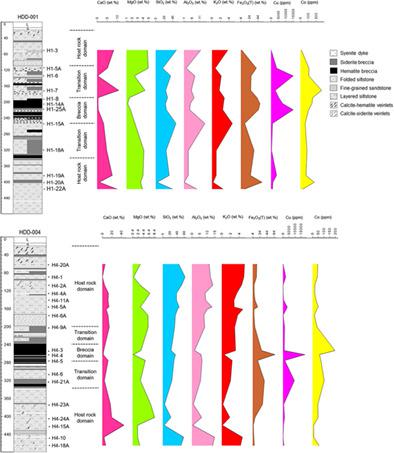赞比亚蒙姆瓦地区Kitumba铁氧化铜金体系外围带(靶区H)热液蚀变与Cu-Co成矿作用
IF 0.8
4区 地球科学
Q3 GEOLOGY
引用次数: 1
摘要
目标H是在赞比亚中部蒙姆瓦地区发现的一个新的铜远景区。mumwa地区的铜成矿作用与与Hook岩基花岗岩-石英正长岩侵入有关的热液系统有关。热液系统的范围尚未被记录,但在花岗岩-石英正长岩体的边缘发现了各种Cu远景,包括目标H。本研究的目的是利用岩石学、地球化学和硫同位素资料研究Target H远景区的地质特征,以了解热液系统边缘的矿化特征。富铜和富钴矿体赋存于与新元古代加丹加超群的昆德隆古群相关的粉砂岩和角砾岩中。粉砂岩由砂岩和泥岩的交替层组成,泥岩由成岩石英、钠长石、白云岩、方解石和白云母组成。角砾岩平行于层理面,产于褶皱破碎粉砂岩单元中。岩石地层学分为角砾岩、过渡岩和寄主岩三个领域,并根据粉砂岩和角砾岩的比例进行划分。热液蚀变对成岩矿物进行了改造,其蚀变产物受寄主岩石原生矿物学控制:粉砂岩中的钾长石和白云母取代了钠长石和白云母,角砾岩中的菱铁矿和赤铁矿取代了白云石和方解石。细脉中存在热液方解石,含或不含菱铁矿和赤铁矿。铜成矿与热液蚀变有关,以黄铜矿、斑铜矿和辉铜矿的形式赋存于角砾岩和网状矿脉中。地球化学与岩性对比图表明,铜成矿主要赋存于角砾岩中。角砾岩中Co与Cu存在异常富集,但两种金属表现出不同的富集和衰竭行为。富铜矿体形成于赤铁矿为主的角砾岩域中,富钴矿体形成于过渡域菱铁矿为主的角砾岩单元中。除Cu、Co外,角砾岩中Fe、P、Ba、Mo、Pb、W、U、V及轻稀土元素均富集。硫同位素特征表明,角砾岩的δ34S值较轻,约为5 ~ 9‰,粉砂岩的δ34S值较重,约为17 ~ 28‰。角砾岩中硫化物的δ34S值与位于热液系统中心的Kitumba矿床的δ34S值相当。本文认为靶区h段角砾岩中富含Cu和Co的矿体为岩浆热液成因,角砾岩是Kitumba矿床中富含氧化铁的含金属流体的通道。流体与富含白云石的粉砂岩的冷却和反应引发了氧化还原反应,沉积了硫化铜矿物和异常浓度的Co。本文章由计算机程序翻译,如有差异,请以英文原文为准。

Hydrothermal alteration and Cu–Co mineralization at the peripheral zone (Target H) of the Kitumba iron–oxide copper–gold system, Mumbwa District, Zambia
Target H is a new Cu prospect discovered in the Mumbwa district of central Zambia. Copper mineralization in the Mumbwa district is linked to the hydrothermal system associated with the granite‐quartz syenite intrusions of the Hook batholith. The extent of the hydrothermal system has not been documented, but various Cu prospects, including Target H, have been discovered at the margins of the granite‐quartz syenite bodies. The objective of this study is to investigate the geological characteristics of the Target H prospect using petrographic, geochemical, and sulfur isotope data in order to understand the features of mineralization at the margin of the hydrothermal system. The Cu‐ and Co‐rich orebodies are hosted in siltstone and breccia correlated to the Kundelungu Group of the Neoproterozoic Katanga Supergroup rocks. The siltstone consists of alternating beds of sandstone and mudstone that are composed of diagenetic quartz, albite, dolomite, calcite, and muscovite. Breccia occurs parallel to the bedding planes and in the folded and fractured siltstone units. Lithostratigraphy is characterized by three domains: breccia, transition, and host rock, which are defined depending on the proportion of siltstone and breccia. The diagenetic minerals have been modified by hydrothermal alteration, resulting in alteration products controlled by the primary mineralogy of the host rocks: K‐feldspar and muscovite replace albite and muscovite in siltstone, while siderite and hematite replace dolomite and calcite in breccia. Hydrothermal calcite is observed in the veinlets with or without siderite and hematite. Copper mineralization is associated with hydrothermal alteration and occurs as chalcopyrite, bornite, and chalcocite in breccia and stockwork veins. Diagrams correlating geochemistry to lithology show that the bulk of Cu mineralization is hosted in the breccia. An anomalous concentration of Co occurs with Cu in breccia, but the two metals do not show similar enrichment and depletion behaviors. The Cu‐rich orebody forms in hematite‐dominated breccia domain, whereas Co‐rich orebody forms in siderite‐dominated breccia units in the transition domain. In addition to Cu and Co, geochemical data show significant enrichment of Fe, P, Ba, Mo, Pb, W, U, V, and light rare earth elements in the breccia. Sulfur isotopic values of sulfide minerals show lighter δ34S values between 5 and 9‰ in the breccia and heavy δ34S signatures of approximately 17–28‰ in the siltstone. The δ34S values measured from sulfides in the breccia were comparable to the values obtained from the Kitumba deposit, which is located at the center of the hydrothermal system. We propose a magmatic‐hydrothermal origin for the Cu‐ and Co‐rich orebodies in the breccia at Target H. Breccia was the conduit for iron‐oxide‐rich metal‐bearing fluids that originated from the Kitumba deposit. Cooling and reaction of the fluids with dolomite‐rich siltstone triggered a redox reaction that deposited Cu sulfide minerals and an anomalous concentration of Co.
求助全文
通过发布文献求助,成功后即可免费获取论文全文。
去求助
来源期刊

Resource Geology
地学-地质学
CiteScore
2.30
自引率
14.30%
发文量
18
审稿时长
12 months
期刊介绍:
Resource Geology is an international journal focusing on economic geology, geochemistry and environmental geology. Its purpose is to contribute to the promotion of earth sciences related to metallic and non-metallic mineral deposits mainly in Asia, Oceania and the Circum-Pacific region, although other parts of the world are also considered.
Launched in 1998 by the Society for Resource Geology, the journal is published quarterly in English, making it more accessible to the international geological community. The journal publishes high quality papers of interest to those engaged in research and exploration of mineral deposits.
 求助内容:
求助内容: 应助结果提醒方式:
应助结果提醒方式:


